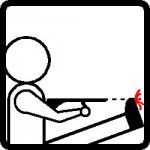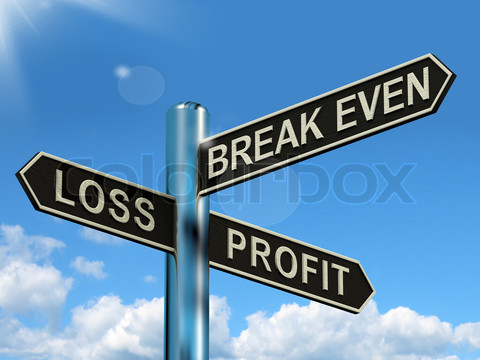09 Nov 2011
8 Ways You Sabotage Your Own Success in Business
As a business owner, I’ll bet you’re incredibly busy and find that there never seems to be enough hours in the day to complete all your work.
Have you ever noticed that some of your everyday activities are just deeply ingrained habits – driving your car, putting on your watch, brushing your teeth or taking a shower? You wouldn’t dream of not doing them, they are part of your routine and they just seem to happen automatically. In your business you also have habits such as checking your website, opening the mail, reading emails, grabbing a coffee and glancing at your diary. You do them without conscious “thought” and they seem to fill up hours in your day…
But what about all the actions you need to take in order to build a more profitable and efficient business? Like following up with your best customers, asking for referrals, strategic planning and goal setting to grow your business? When do you do these activities? Do they often get relegated to “tomorrow” or “sometime soon”?
If you’ve ever spent your day stuck in back to back meetings, answering routine questions from your team, responding to emails, helping other people, doing paperwork or tidying your office – you already know that these are “make busy” activities, and they will keep you trapped where you already are – just simply maintaining, not growing your business. By filling your days with these tasks, you are in effect avoiding the very activities that you know will really move your business forward and produce tangible results.
Your “make busy” work or habits create the magnificent illusion that you are hard at work, simply because you feel “flat out” and your day is full of tasks. Let’s be honest, you would actually rather do anything than face the activities you know would radically accelerate your business success NOW! In fact, you often get to the end of the day and say to yourself “It’s OK, I was really busy, I’ll just get to that marketing plan tomorrow.” Or “I just couldn’t find the time today to make that seminar on leadership or customer loyalty.”
If you are waiting for the right or best time to do these critical activities in your business, it will simply never come! There will always be other “busy work” to fill all of your available time. You need to find a way to make your business building activities an ingrained habit too, if you want to grow your bottom line and live the lifestyle of your dreams.
Do you relate to or identify with any of these common sabotage habits?
1. Perfectionism – this tactic is insidious. It often immobilizes us from making a decision, starting a project or activity and signing off on a piece of important work. Most tasks don’t have to be 100% perfect, they just need to be good enough. The other way that this can show up is when you deceive yourself into believing that no-one else can do the job (even simple routine tasks) to your exacting standard, so you must do it ALL yourself. Follow the 80/20 rule, delegate what you do not have to do yourself and give yourself permission to be human!
2. Refusing to Let Go of The Past – Have you ever heard yourself say “last time I tried that, it didn’t work”? Or have you ever simply avoided doing something that you know you should or need to do but were afraid to do because “last time it didn’t work out the way you wanted it to”? Even though it’s a good idea to stop doing what clearly doesn’t work, it’s important to remember that the past does not necessarily equal the future. If you catch yourself finding reasons from the past to justify why you are not moving ahead toward your compelling future, stop NOW and take a good hard look at whether these are just cleverly disguised forms of self-sabotage.
3. Lack of Accountability – who is holding you accountable to the decisions you make and the actions you take in your own company? Isn’t that why you went into business for yourself in the first place – so that you could be the boss and do things your way? Find someone outside your business – a coach, mentor or trusted advisor that can act as a sounding board and hold you accountable to staying on track.
4. Lack of vision, planning and specificity – if you don’t know where you are going, how will you know when you get there? Enough said. If you don’t have a 90 day, 1 year and 3 year business plan, you need to make this your number one priority in your business. Set a weekend aside and find a place where you will not be disturbed by anyone or anything. Set down your goals clearly and succinctly – get clear about the specifics (who, what, where, when and why) and set realistic deadlines for completion. Goals need to be written down in detail to allow your mind – which is a goal seeking mechanism – to do its magic.
5. Lack of focus – stay focused on the important task you are currently working on and only allow yourself to be diverted by real emergencies.
6. Fear of Financials – you cannot have a truly successful business if you don’t know your numbers. Not knowing your numbers has already cost you time and money. Find someone who can explain your financials to you in plain English – learn the key drivers and indexes in your business (such as break even, productivity ratios, inventory turns, gross profit margins etc.) and track them daily.
7. No USP – the greatest product or service in the world will not sell if you have not clearly defined why someone should buy from you instead of your competitors. “Build it and they will come is a fallacy.” If you have not yet figured out what is unique about your product or service and found a compelling and cost effective way to communicate it in everything you do, you are literally flushing your marketing budget down the toilette.
8. No Testing and Measuring – this is the most-often overlooked activity by small business owners. The simple act of testing and measuring everything in your business…and I mean everything…will save you thousands of dollars this year. No matter what “it” is, if you haven’t tested and measured “it”, you don’t really know if “it” works. And until you know if it works, you don’t have a reliable, predictable business that will run without out.
Unfortunately, there are no quick fixes. As you already know or suspect, some of the most common forms of self-sabotage are habits because they are deeply ingrained behaviours that take time to establish or eliminate. In the 1960’s a highly regarded plastic surgeon, Dr. Maxwell Maltz discovered that it took 21 days for amputees to cease feeling phantom sensations in their amputated limb. From further observations and significant research he established that it takes 21 days to create a new habit.
Brain circuits take engrams (which are essentially “memory traces”) and produce neuroconnections and neuropathways only if they are bombarded for 21 days in a row. This means that our brain does not accept new data or information for a change of habit unless it is repeated each day (without fail) for at least 21 days. Changing habits (whether positive or negative) can be done but it takes time and consistent effort.
Do yourself a favour and identify today which form of self-sabotage is the primary one that is holding you back from having the business and lifestyle of your dreams. Make a plan on paper – specific decisions and actions that you can take to move forward in this aspect every single day for the next month. It is imperative to track your progress each day and I highly recommend finding an objective person outside of your business to hold you accountable to your plan, actions and results.
Is your business growth starting to plateau or stagnate?
It’s easy to sit back, take the foot off the accelerator and watch the sales roll in, especially if you’ve been satisfied with your recent performance. But keep in mind that if you slack off too much, your competitors will soon catch up and eventually put you out of business.
Take a look around – businesses (and your competitors) are closing their doors due to the drop in consumer spending – which means MORE potential customers for businesses like YOU, that do survive. Today is the best time to take steps to revamp your marketing efforts and respond to the needs and the pain of your target market.
In these tough times, it’s going to take more than “thinking outside the box” and goodwill with existing customers to secure the survival of your business.
I want you to STOP right now and make a list of everything that you (and your competitors) do NOT do to make it easy for your prospects to buy from you. If you want to succeed over the long term, you will take a good hard look at both of these lists and find a way to do whatever it takes, for as long as it takes, to win your customers and keep them.
Granted, this is not an easy task. Most businesses will continue to do what they have always done – guess or assume what they think their customers need. However, no matter how challenging it is to ask the hard questions and re-engineer your strategy, I guarantee it will be a whole lot less painful and stressful than going under.
I had a married couple come to me once for advice and coaching – both the business they were in and their relationship were at the breaking point. The husband turned and said to me “I don’t understand it. I do everything humanly possible for my wife and she doesn’t appreciate me and I don’t think I can possibly do anything more to satisfy my customers – they are never happy and always want more. What can I possibly do?”
My answer to this age old dilemma applies to him, his marriage, and to you in your business right now. “Sounds like you are doing a lot. Too bad it’s everything BUT the very thing that your partner and customers need most.”
While this may sound harsh, I think you will agree that it is absolutely true. It does you no good to work harder doing everything…instead of focusing on the 1 thing that you customers actually need. Wouldn’t it be easier for you to work smarter, not harder, if you knew with absolute certainty what that 1 thing is?
How can you take the lesson from my client and apply it to your own business right now?
How could you go about figuring out what that 1 thing is?
I want you to do something really radical today and start asking both your prospects and existing customers what they need. You need to find out:
• What is the biggest challenge your prospects are facing in their business?
• When your customer thinks of the product or service you provide, what is THE most painful or difficult issue associated with acquiring it?
• What is the most important criteria to your purchaser when evaluating a company like you?
• What are some things that he/she thinks about or considers from a financial perspective when selecting that product/service or a vendor?
• What is the key strategic driver for you customer’s decision?
It doesn’t really matter what you have done up to this point or how hard you are working. There is no prize for volume or quantity. What counts is quality and relevance.
Are you giving your customers what they want and are you willing to do whatever it takes to help them cure the pain that they are in?
More of the “same old same old” is not going to differentiate you from the pack, build trust, win customers and grow your business. Take some time today to really think about what you offer and how it could be improved to meet the primary need of your customers. If all of your customers were to leave today, what would you need to change in order to win them back and survive?
At the end of the day, price is never the determining factor. Once you uncover the true cost of the problem they are facing, price becomes irrelevant. Your customers will always be willing to pay a fair price for a product/service that cures their pain – not to mention the peace of mind that comes with excellent service. Take stock of what the competition is NOT willing to do and what your customers wnat most from you.
Do something unique – listen and be willing to do whatever it takes to deliver what they want (and need). Anything less, is simply a waste of your time and money on everything that doesn’t really matter.
Article Source: http://EzineArticles.com/6586203
18 Sep 2011
Is Bottled Water Making You Stupid?
Bottled water is THE most profitable drink product in the world, selling for 3000 to 9000 times what you pay for the perfectly safe, inexpensive liquid that comes out of your tap at home.
To put this in context, paying $2.40-3.90 for a 750ml bottle of water is equivalent to:
• $10,000 for a tuna sandwich at your local cafe or
• A bill from your water company this month for $3000/tonne of water (as opposed to the going rate of $1.2/tonne)
According to the Australasian Bottled Water Institute, Australians consume over 250 million litres a year at a price of $385 million. We have been systematically brainwashed by the beverage industry to believe that our tap water is somehow unsafe or insufficient – look around and you will see that there are now hundreds of brands competing for your attention with clever marketing campaigns designed to scare, seduce and mislead you to part with your hard earned money.
Despite its association with prestige, purity and pristine conditions, bottled water is often no better than tap water (in terms of taste and cleanliness) and the production process it is extremely harmful to our environment.
Did you know that:
• For every 250 million litres of bottled water, it takes 125million litres of oil to produce the plastic bottles, refrigerate and ship them from one part of the world to another
• For every litre of bottled water sold, another 2 litres are used up in the production process
• More than ½ of the brands on the market are derived from municipal water supplies, despite the fact that the packaging would lead us to believe they come from unspoiled mountain streams or underground springs
• Over 80% of the bottles end up in landfills and are never recycled
It is estimated that bottled water has become a more than $45 billion dollar industry worldwide. Surprisingly, 97% of it is consumed in countries which have plentiful sources of clean, safe drinking water. We can afford to turn our noses up, avoid the tap and fork out millions for bottled water: our choice however is purely a lifestyle one. A lifestyle choice for us with life and death consequences for others and our planet.
For 2.6 billion people in the developing world, lack of clean water and basic sanitation is a life or death situation. It is estimated that half of the people in the developing world are suffering from diseases associated with inadequate water or sanitation and that 5 million people die each year. According to the International Water Management Institute, clean water and improved sanitation could be provided to everyone on earth for an outlay of $11 billion a year (less than a quarter of our global $45 million spending on bottled water), yet to date, there has been no impetus to re-channel the money and change our thinking on this important issue.
So you may be sitting there and thinking, what does this mean for YOU and your business?
Well, nothing… and yet perhaps, everything.
How often have you (or someone else in your team) said:
• “if we had more money, we could invest in X and improve our business?”
• “if we put our prices up by 10%, we will lose customers.” or
• “we can’t afford to buy X because it’s too expensive.”
You already have enough money to do and buy all of the things that you need – it’s simply a matter of common sense and priorities. We are all affluent in this country: It is your mindset and your language which is lacking, not your bank account.
In fact, each and every day you and I waste money by overpaying for bottled water and other convenience/impulse items. We rarely stop to think about the true value of what we got vs. what we paid. Bottled water is just one obvious example and it is not difficult to see how this might be playing out in other areas of our lives.
You and I have happily overpaid for products. Yet we struggle to charge what we are worth or put our prices up because we fear that no one will buy. Isn’t that interesting?
Perhaps you and I need to take a lesson from the bottled beverage industry and focus on how we are marketing and selling our products/services? Is fear more powerful than selling benefits? Is perception more influential than reality? Are you seducing your customers with sizzle or merely putting them to sleep with your low prices?
Think about it. Beverage companies have managed to package and sell to us something that is practically free and plentifully abundant, for thousands of times what it is worth. And up until now, we have all paid willingly. Bottled water has in fact made us all look a bit foolish.
Maybe it’s not the price you are charging that is the problem? It’s the way you are choosing to promote your product/service. The best time to change your mindset and your approach is now. Anything is possible.
Article Source: http://EzineArticles.com/4936397
That’s The Good News, Now Do You Want To Hear The Bad News?
If you do a quick search on the internet, you will uncover hundreds of experts, coaches, accountants, journalists and government organizations that quote the statistic “8 out of 10 business fail in the first year”. However, the fact that the statistic is widely touted doesn’t necessarily mean that it’s true or backed up by empirical evidence.
So what is the truth? I searched the internet and couldn’t find confirmation of any study that was done to back-up this statistic (that 8 out of 10 businesses fail) by a reputable or well-known bureau. What I did in fact find was some evidence to the contrary. According to credit reference checking agency Veda Advantage, only a small percentage of new businesses close in their first 12-months of business.
What is the exact amount, you ask? Would you believe, less than two percent?
However, they assert another 32 percent close their doors between their second and fifth year of operations, while 21 percent wind up between the sixth and ninth.
So, that is the good news. However, as you can probably guess, it’s not ALL good news.
Just because a start-up doesn’t go under in the first 12 months, doesn’t mean that the owner is running a successful enterprise. I wonder if anyone has bothered to measure how many of the businesses who survived:
- Paid the owner a wage that was at least equivalent to what he/she could have earned elsewhere as an employee?
- Generated a profit and positive cash flow? and
- Had enough working capital to service their debt, pay taxes and suppliers etc. as they came due?
The first few years of business are incredibly risky. In working with hundreds of business owners, we have found that the large majority opt to forgo their salary or inject more equity to prevent them from going under prematurely. What this means is that, while they may not have “technically” gone under, these fledgling enterprises are far from commercially viable and successful.
Statistics can be both helpful and misleading at the same time. It is easy to assert figures but more difficult to substantiate their veracity or explain the implications thereof.
The author of an article or press release will often use statistics to capture your attention and motivate action. That’s why people use statistics – numbers are persuasive and have an aura of authority. A statistic like – 8 out of 10 businesses fail – gets attention, doesn’t it? Whether this data is accurate or not, is only half the story. As a business owner or manager, we must look deeper to find the insights that we can take away and use to improve our results.
Personally, I don’t care what percentage goes under. No matter how long you’ve been operating, if you’re not getting paid a salary, producing profit and generating positive cash flow, you’re not running a successful company. Closing your doors is only half the story. The doors may very well be wide open, but technically, no one is there.

Rhondalynn Korolak, Author of Financial Foreplay® and On The Shoulders of Giants
Discipline and attention to details is more important than ever if you want to succeed in challenging economic times. Take a look around… competitors are closing their doors – which means more potential customers for the businesses that DO survive. And in times like these, it’s going to take more than “thinking outside the box” and goodwill with existing customers to secure the survival of your business.
You may have been lucky over the past few years – you may have found it possible to operate without a detailed, written plan and systems/processes. But the global economic crisis has changed all of that. If you want to thrive, there is only one thing that is for sure – uncertain times call for deliberate decisions and proven practices.
So here are & top tactics to recession-proof your business.












